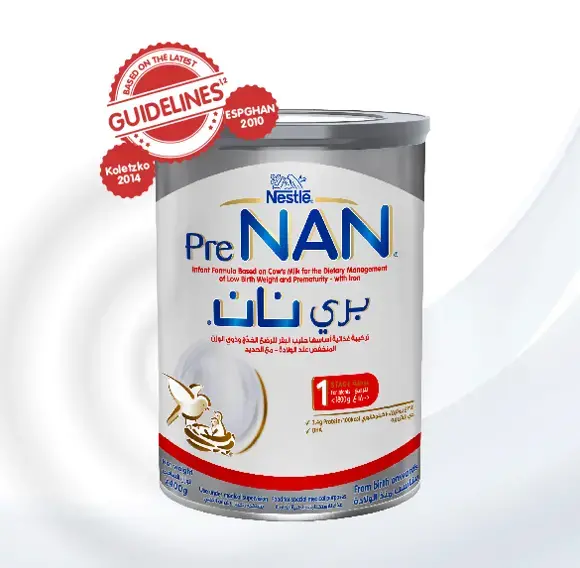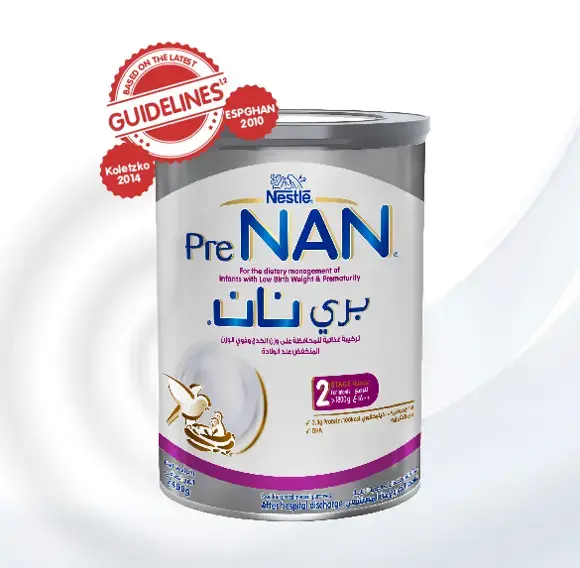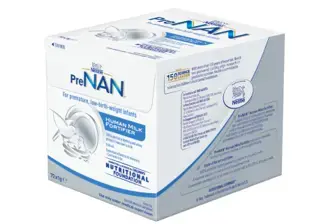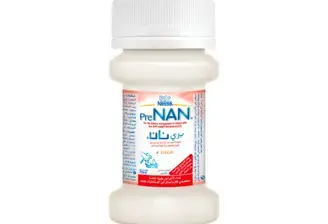
NAN FORMULA SPECIALTIES
An infant’s experiences in their first 1,000 days of life — from conception to age 2 — can have a profound lifelong impact on their health and wellbeing. There are several challenges that an infant may face during this sensitive period and making sure they get the right nutrition and care in the early years will help set them up for a healthy life.
REGURGITATION
Regurgitation is a common gastrointestinal disorder during infancy. The burden of daily regurgitation in infants below 6 months is estimated to be around 50-60%.1 Regurgitation may also represent the first manifestations of an authentic Gastroesophageal Reflux Disease (GERD) and risk being followed by later subsequent complications such as apnea, feeding and swallowing, airway disease and failure to thrive.2 The pathogenesis of regurgitation and reflux is multifactorial, including key abnormalities such as functional immaturity of the lower esophageal sphincter and delayed gastric emptying.3,4

NAN® A.R. COMBINES THE BENEFITS OF THICKENED AND WHEY PREDOMINANT FORMULA WITH L. REUTERI
Thickened with starch, NAN® A.R. has been specifically designed for formula fed babies from birth with regurgitation
BENEFITS

- Increases viscosity for a more stable bolus.5,6
- Reduces regurgitation in infants7
- Offers long-term relief from regurgitation in infants8
- Approved by the European Society for Paediatric Gastroenterology Hepatology and Nutrition (ESPGHAN)9,10

- An optimized protein blend that supplies the right amount and quality of proteins needed for the baby’s healthy growth5
- Accelerates gastric emptying6
- Provides gastric emptying rate closer to that of breast milk6,11

- A unique probiotic naturally present in breast milk12
- Improves gut motility and accelerate gastric emptying12-15
- Promotes a healthy gut flora to maintain a balanced gut microbiota12-15
- Modulates gut immune responses for added protection from pathogens12-15
DIARRHEA AND LACTOSE INTOLERANCE
Diarrhea is a leading cause of mortality and considered a serious health hazard for children, especially for those under the age of five.16-18 Lactose intolerance is a common complication of acute diarrhea in infants. In case of lactose intolerance due to diarrhea, it may take infants up to 8 weeks to recover their full ability to digest lactose.19,20

DIARRHEA AND LACTOSE INTOLERANCE CAN ESTABLISH A VICIOUS CYCLE 21,22
NAN® L.F. FIRST EVER FORMULA TO COMBINE BENEFITS OF NO LACTOSE, NUCLEOTIDES, PROBIOTICS AND LOW OSMOLARITY
Nestlé NAN® L.F. is the first ever lactose-free infant formula with L. reuteri active probiotic cultures specially designed to help with the dietary needs of babies suffering from lactose intolerance and diarrhea.

BENEFITS
Lactose-Free
- Prevents further worsening of diarrhea23
- Lowers stool output24,25
Nucleotides
- Facilitates gut repair26,27
- Lowers incidence of diarrhea28
- Improves intestinal permeability and absorption29
- Promotes healthy gut flora30
- Shortens duration of diarrhea31
- Reduces stool frequency31
- Shortens hospital stay31
ADDITIONAL BENEFITS

Contains DHA & ARA
Known for immuno-modulatory effects and improved cognitive function32,33

Whey predominant
For easy digestion and high protein quality11

Rich in alphalactalbumin
To achieve an amino-acid composition closer to that of human milk6

Offers weight gain
Improvement in weight gain after 5 days of the treatment34
PREMATURITY
Preterm infants face many challenges that call for specialized nutritional support. They have distinct physiological characteristics compared to full-term infants.
Key challenges in preterm and low birth weight (LBW) infants include higher growth rates, depleted nutrient stores at birth, gastrointestinal (GI) immaturity. As a result, they have specific and evolving nutritional needs to replenish their nutrient stores, support catch-up growth and compensate for immature GI functions. Adequate nutrition is essential to support catch-up growth and development.35-40

Nestlé PreNAN® ADVANCED NUTRITION FOR PRETERM AND LOW BIRTH WEIGHT INFANTS
Nestlé PreNAN® Stage 1 is specifically adapted for feeding the rapidly growing preterm and low birth weight infant (<1800g) during the hospital stay
BENEFITS

81 (kcal/100 ml)
Compensates for limited gastric capacity and provides higher energy41
3.4 (g/100 kcal)
Whey/casein ratio 70/30
5.1 (g/100 kcal)
The fat blend has been improved to promotes optimal brain & visual development, and improved nutrient absorption39,40,43-46
Adapted levels of intact protein to support optimal growth39-43
In line with the latest nutritional guidelines for preterm infants to support growth & development39,40
Nestlé PreNAN® Stage 2 is specifically adapted for feeding the rapidly growing preterm and low birth weight infant (>1800g) after hospital discharge.
BENEFITS

Bifidus BL supplementation in preterm infants:
- Promotes healthy microbiota development47
- Enhances GI immunity48
73 (kcal/l00ml)
Compensates for limited gastric capacity and provides higher energy41
Intact protein
2.8 (g/100 kcal)
Whey/casein ratio 70/30
5.1 (g/100 kcal)
Unique fat blend to promotes optimal brain & visual development39,43-46
In line with latest guidelines: Koletzko 2014, ESPGHAN 2010
* Codex IF-72-1981
References:
1. Vandenplas Y, et al.Acta Paediatr. 2015;104(5):449-57.
2. Shepherd RW, et al. Clin Pediatr (Phila). 1987 Feb;26(2):55-60.
3. NIDDK. Gastroesophageal Reflux (GER) and Gastroesophageal Reflux Disease (GERD) in Infants. NIH Publication No.13–5419. September 2013.
4. De Giorgi F et al. Acta Otorhinolaryngol Ital.2006;26:241-246.
5. NAN® A.R. Labeling Information 2022.
6. Data on file. Nestlé Middle East.
7. Valverde A et al. [Estudio del tratamiento dietetico de las regurgiaciones mediante una leche para lactantes de consistencia modifi cada. Ensayo clinico NIDINA A.R.]. in NIDINA A.R. ensayos clinicos. Pulso ediciones s.a., Nestlé Espana S.A. 1998:14-28.
8. Chevallier B, et al. Ann Pediatr (Paris). 1998;45(7):509-15.
9. Aggett PJ et al. JPGN. 2002;34(5):496-8.
10. Koletzko B et al. JPGN. 2005;41(584):599.
11. Billeaud C, et al. Eur J Clin Nutr. 1990;44(8):577-83.
12. Sinkiewicz G, et al.Microb Ecol Health Dis.2008;20:122-6.
13. Indrio F, et al. Eur J Clin Invest. 2011;41(4):417-22.
14. Papagaroufalis K, et al. Safety assessment of a starter formula containing D-lactate producing probiotic Lactobacillus reuteri DSM 17938 during the first months of life. Abstract at Pediatric Academic Societies (PAS) ; April 2012.
15. Liu et al. Am J Physiol Gastrointest Liver Physiol 2010;299(5):G1087-96.
16. Fischer Walker CL, et al. BMC Public Health. 2012 Mar 21;12:220.
17. Liu L, et al. Lancet. 2012;379(9832):2151-61.
18. WHO World Health Statistics 2014. Available at: http://www.who.int/gho/publications/world_health_statistics/2014/en/. Accessed 19 January 2015.
19. Gabr M, et al. Clin Ther. 1979; 2: 271-6.
20. Heyman MB, et al. Pediatrics. 2006 Sep;118(3):1279-86.
21. Swagerty D, et al. Am Fam Physician 2002; 65(9): 1845-50.
22. Andrade JAB, et al. J Pediatr (Rio J) 2000; 76 (Suppl 2): s119-s126.
23. Lebenthal E, et al. J Pediatr. 1980;97(3):389-93.
24. Fayad IM, et al. Arch Pediatr Adolesc Med. 1999 Jul;153(7):675-80.
25. Rajah R, et al. J Pediatr Gastroenterol Nutr. 1988 Mar-Apr;7(2):203-7.
26. Slízová D, et al. Acta Medica (Hradec Kralove). 2004;47(3):163-6.
27. Uauy R, et al. J Nutr. 1994 Aug;124(8 Suppl):1436S-1441S.
28. Brunser O, et al. Acta Paediatr. 1994 Feb;83(2):188-91.
29. Kukuruzovic RH, et al. J Paediatr Child Health. 2002 Dec;38(6):571-7.
30. Shornikova AV, et al. Pediatr Infect Dis J. 1997;16(12):1103-7.
31. Weizman Z, et al. Pediatrics 2005;115(1): 5-9.
32. Brenna JT, et al. Am J Clin Nutr. 2007 Jun;85(6):1457-64.
33. Hoffman DR, et al. Prostaglandins Leukot Essent Fatty Acids. 2009 Aug-Sep;81(2-3):151-8.
34. Woweries J, et al. Pädiatr Grenzgeb 1997;36:137-144.
35. Fenton T, et al. BMC Pediatrics 2013, 13(59), 1-13.
36. Neu J. Am J Clin Nutr 2007, 85(2), 6295-6345.
37. Stratiki Z, et al. Early Hum Dev 2007, 83(9), 575-9.
38. Gritz EC, Bhandari V. Front Pediatr 2015, 3:17.
39. Koletzko B, Poindexter B, Uauy R. Nutrition care of preterm infants: Scientific basis and practical guidelines. World review of nutrition and dietetics. Koletzko B, Poindexter B, Uauy R eds, KARGER, 2014.
40. Agostoni C, et al. J Pediatr Gastroenterol Nutr 2010, 50(1), 85-91.
41. Data on file. PreNAN®. Nestlé.
42. Brown LD, et al. Clin. Perinatal 2014, 41 (2), 383-403.
43. Delplanque B, et al. J Pediatr Gastroenterol Nutr 2015, 61 (l), 8-17.
44. Carnielli VP, et al. Am J Clin Nutr 1995, 61(5), 1037-42.
45. Lucas A, et al. Arch Dis Child Fetal Neonatal Ed, 1997, 77(3), Fl78-84.
46. Thakkar S, et al. MCT in preterm infant nutrition formulations: critical review of the available science, Nestlé Internal note, April ll, 2012.
47. Mohan R, et al. J Clin Microbio 2006, 44(11), 4025-31.
48. Mohan R, et al. Pediatr Res 2008, 64(4), 418-22.
IMPORTANT NOTICE
We believe that breastfeeding is the ideal nutritional start for babies as breast milk provides a balanced diet and protection against illness for a baby. We fully support the World Health Organization’s recommendation of exclusive breastfeeding for the first six months of life followed by the introduction of adequate nutritious complementary foods along with sustained breastfeeding up to two years of age.
We also recognize that breastfeeding may not be an option due to certain medical conditions. Parents should only feed Infant formula for special medical purposes under supervision of a healthcare professional after full consideration of all feeding options, including breastfeeding. Continued use has to be assessed by the health professional in relation to the baby's progress bearing in mind any social and financial implications for the family.
Infant formula should always be prepared, used and stored as instructed on the label in order to avoid risks to a baby’s health.

